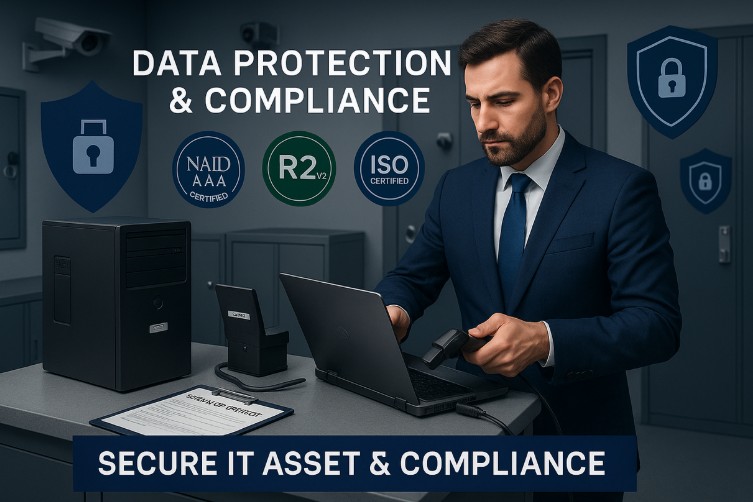Why Compliance in IT Asset Disposal Is No Longer Optional
In an era where data breaches cost businesses an average of $4.45 million per incident, and non-compliance penalties can soar to $24 million or 4% of global turnover, managing the disposal of IT assets is no longer just an operational task—it’s a critical compliance and security imperative.
With evolving federal mandates, international data privacy regulations, and increasing environmental expectations, enterprises must navigate a complex web of legal, technical, and ethical responsibilities when decommissioning IT equipment. Failure to do so can result in catastrophic data leaks, regulatory fines, reputational damage, and loss of customer trust.
Understanding IT Asset Disposal
IT Asset Disposal (ITAD) is the process of securely and responsibly retiring obsolete or unwanted IT equipment, ranging from laptops and servers to mobile devices, storage media, and network equipment. But ITAD is far more than just “taking out the trash.”
At its core, a successful ITAD strategy delivers three critical outcomes:
- Data Security: Prevents unauthorized access to sensitive information
- Regulatory Compliance: Meets legal obligations for data handling and waste management
- Environmental Responsibility: Minimizes e-waste and hazardous material exposure
Effective ITAD requires planning, execution, and validation at every step. Enterprises must develop internal protocols and select trusted external partners to manage every phase of the IT asset lifecycle.
Organizations must also evaluate the financial impact of idle equipment or improperly recycled hardware. A well-structured ITAD program can improve return on investment (ROI) through hardware resale or reuse while ensuring secure data handling. Additionally, it reduces the burden on internal IT teams by streamlining decommissioning workflows and enforcing compliant handling of legacy devices.
Navigating Legal and Regulatory Requirements in IT Asset Disposal
Ensuring compliance requires a thorough understanding of the laws and regulations governing data protection, hazardous waste, and equipment disposal. Non-compliance not only leads to financial penalties but also exposes organizations to legal action and reputational damage.
Federal and State Regulations in the U.S.
In the United States, businesses must comply with a range of regulatory mandates, including:
- The Resource Conservation and Recovery Act (RCRA) regulates hazardous waste disposal, including e-waste, and mandates proper handling of toxic substances like lithium batteries and PCBs.
- State-specific e-waste laws vary significantly by region. For example, California enforces stricter e-waste recycling protocols than most other states.
Each state may also impose unique requirements for how e-waste is collected, processed, and reported, making it essential for IT managers to work with ITAD vendors experienced in multi-jurisdictional compliance.
International ITAD Compliance Standards
Internationally, companies handling sensitive data must ensure adherence to regulations such as:
- HIPAA (Health Insurance Portability and Accountability Act): Mandates protection and proper disposal of protected health information (PHI). Violations can result in class-action lawsuits and substantial fines.
- GLBA (Gramm-Leach-bliley Act): Requires financial institutions to dispose of customer data securely.
- WEEE Directive (EU): Enforces responsible recycling of electronic waste across Europe, from collection to final disposal.
Global organizations must align their ITAD strategies with the most stringent applicable laws to minimize cross-border compliance risks.
The Importance of Documentation and Record-Keeping
Regulatory agencies increasingly require audit-ready documentation to verify ITAD compliance. Essential documentation includes:
- Certificates of data destruction and disposal
- Detailed inventory logs with serial numbers and asset tags
- Proof of engagement with certified vendors
Thorough recordkeeping enables internal stakeholders to track performance, conduct risk assessments, and respond quickly to audits, legal inquiries, or customer questions.
Best Practices for Compliant and Secure IT Asset Disposal
- Conduct Regular IT Asset Disposal Risk Assessments
Before initiating any disposal process, businesses should assess:
- What types of data are stored on devices?
- What are the risks of unauthorized data recovery?
- What compliance requirements apply based on location and industry?
Risk assessments should be conducted periodically and documented formally. Involving information security (InfoSec) and legal teams provides additional insights and institutional safeguards.
These evaluations must also account for insider threats and exposure risks during offboarding or decommissioning. A thorough risk assessment identifies protocol gaps and supports the development of controls that align with industry standards and internal policies.
- Implement Enforceable Data Destruction Policies
Create and enforce policies that include:
- Data wiping or erasure per NIST 800-88 Rev.1 guidelines
- Use of disk sanitizing software for non-physical destruction scenarios
- Secure destruction of media like USB drives and hard disks
Policies should be reviewed at least annually and integrated into broader information governance frameworks to remain aligned with evolving technologies and regulations.
Clear communication is key, especially between IT, compliance, and operations teams. Employees responsible for equipment handling must be trained to tag assets, follow destruction protocols, and verify the certificate of destruction from third-party vendors.
- Use Secure IT Asset Transportation Protocols
Transporting retired IT assets introduces potential vulnerabilities. To minimize risk:
- Use GPS-tracked, bonded logistics providers.
- Require chain-of-custody documentation for each shipment.
- Secure assets with lockable containers and tamper-proof seals.
These security measures help prevent theft, loss, or tampering, all of which can result in legal exposure or compliance violations.
- Choose Certified Data Sanitization Methods
Certified sanitization options include:
- Physical destruction, such as shredding or crushing storage media
- Software-based wiping with cryptographic erasure
- Third-party vendors that issue Secure Data Erasure Certificates
When selecting methods, businesses must consider the classification of data and sensitivity level. For example, devices that contain high-risk data, such as personally identifiable information (PII) or protected health information (PHI), often warrant physical destruction. For lower-risk assets, software wiping may be more cost-effective and sustainable, especially if the equipment will be remarketed or repurposed.
Environmental Responsibility in ITAD
Prioritizing E-Waste Recycling to Maximize Recovery and ESG Alignment
The EPA reports that recycling 1 million smartphones can recover 75 pounds of gold, 772 pounds of silver, and 35,000 pounds of copper, highlighting both the environmental and financial benefits of responsible e-waste management.
Proper e-waste recycling:
- Reduces landfill waste
- Conserves natural resources
- Helps companies meet ESG (environmental, social, and governance) reporting standards
- Prevents hazardous materials, like mercury and lead, from contaminating soil and groundwater
E-waste practices aren’t just about compliance—they’re also about demonstrating environmental stewardship and long-term risk reduction.
Partnering with Environmentally Responsible Providers
Partnering with certified vendors who hold recognized certifications such as R2v3 (Responsible Recycling) ensure proper material separation, hazardous waste handling, and worker safety—while meeting both EPA and global environmental standards. This also reflects positively in sustainability audits and annual corporate social responsibility (CSR) reports. Organizations that prioritize sustainability in ITAD send a strong message to investors, customers, and regulators about their environmental commitment.
Leveraging IT Asset Management Systems (ITAM)
An integrated ITAM system streamlines:
- Tracking assets across the full lifecycle, from deployment to disposal
- Automating certificate generation and regulatory reporting
- Aligning asset recovery with ROI and sustainability goals
Modern ITAD platforms can also integrate with enterprise resource planning (ERP) systems, enabling smoother audits and minimizing manual errors. Businesses that adopt these technologies gain real-time insights and operational efficiency, especially across multi-site or global environments. This enterprise-wide oversight enhances resource planning, compliance readiness, and waste reduction initiatives.
Benefits of a Comprehensive ITAD Compliance Strategy
Reduce Risks of Data Breaches Through Secure IT Disposal
The cost of a single breach now averages $4.45 million. Still, secure disposal remains one of the most overlooked security layers. When incorporated into your organization’s InfoSec strategy, ITAD policies help protect sensitive data well beyond the device’s active life.
Avoid Regulatory Penalties with Proactive Compliance
Non-compliance fines from GDPR or HIPAA can exceed millions. A proactive ITAD plan helps demonstrate “reasonable efforts” during regulatory reviews and serves as an audit defense mechanism if breaches occur.
Documented, repeatable processes are your best safeguard against legal exposure and hefty non-compliance fines.
Promote Corporate Sustainability and Governance Maturity
Sustainability reporting is now mandatory for nearly 50% of organizations, especially within the EU and ESG-regulated sectors. Responsible IT asset disposition supports:
- ESG benchmarks and climate disclosures
- Transparent sustainability reporting
- Stronger investor and stakeholder confidence
In today’s environment, compliance is the baseline. True leadership is demonstrated by how responsibly your business manages technology across the entire lifecycle from procurement to end-of-life.
How to Select the Right ITAD Vendors
When evaluating ITAD providers, look for those that offer:
- Recognized certifications (R2v3, ISO 14001)
- End-to-end traceability through asset tracking and inventory control systems
- Integrated reporting tools for audit readiness and sustainability metrics
- Global logistics support and multi-site coordination capabilities
OEMSource delivers all of the above through a trusted vendor network and comprehensive IT lifecycle services—including recovery, reverse logistics, data destruction, and secure recycling. By partnering with OEMSource, your business gains more than compliance—it gains strategic value recovery and environmental leadership.
Contact us today to learn how we help you protect data, meet regulations, and recover value—every step of the way.
Frequently Asked Questions
What is the IT asset disposal policy and procedure?
An ITAD policy outlines steps for securely and compliantly decommissioning IT assets, including data sanitization, certified logistics, documentation, and environmental recycling. It defines roles, responsibilities, and timelines to reduce risk during the retirement of technology assets.
What are the legal requirements for disposing of technology assets?
Legal requirements vary by region but commonly include compliance with frameworks like RCRA, HIPAA, GLBA, WEEE, and state e-waste laws. Many organizations also require certification from responsible recycling bodies such as R2v3.
How do you properly dispose of IT equipment?
Proper disposal involves asset tracking, secure data erasure in accordance with NIST 800-88 compliance, and partnering with certified ITAD vendors who ensure responsible reuse or recycling. The well-structured disposal plan supports both compliance and operational efficiency.
What is the IT asset management disposal process?
The disposal process spans asset decommissioning, secure transit, certified data destruction, and documented recycling. ITAM systems streamline this workflow by enabling real-time tracking, compliance documentation, and reporting for audits and ESG reporting.
Why should I use a certified ITAD provider instead of handling disposal in-house?
Certified ITAD providers ensure compliance with data security, environmental, and regulatory standards. They offer documented processes—like certificates of destruction and chain-of-custody tracking—that reduce legal exposure and audit risk. In-house disposal often lacks the tools, expertise, and certifications needed to meet today’s compliance and sustainability expectations.





